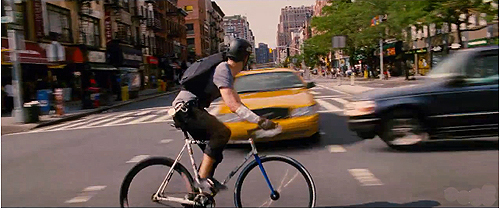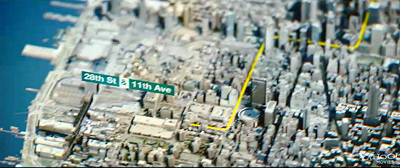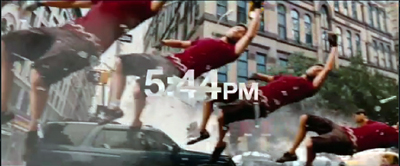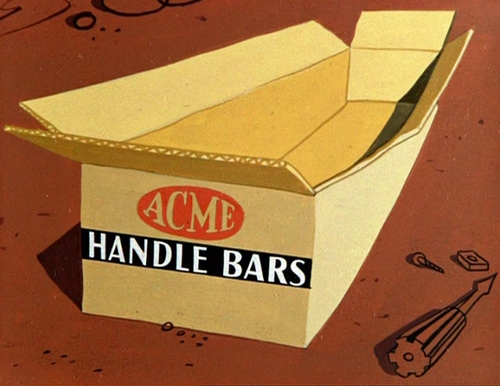Clocked doing 50 in the Dead Zone
Monday | September 3, 2012 open printable version
open printable version
DB here:
August’s final weekend fizzled. Ray Subers of Box Office Mojo writes:
The Expendables 2 repeated in first place on what was easily the lowest-grossing weekend of 2012 so far: the Top 12 added up to $83.8 million, or 12 percent less than the previous low (Feb. 3-5).
This late-summer slot is usually a problem. Here’s Subers on last year’s situation, which included Hurricane Irene.
The weekend as a whole . . . is poised to be one of the slowest of the year, hurricane or no. . . . This crop of new releases [Columbiana, Don’t Be Afraid of the Dark, Our Idiot Brother] is modest at best, though Irene has given Hollywood a convenient excuse.
With few exceptions, both winter and summer have stretches which make it hard for new releases to make headway. January through March and mid-August through September are forbidding Dead Zones. Is it a vicious cycle? Do audiences stay away at these times because most releases have little appeal? Or do the distributors treat these months as dumping grounds because people tend to stay away?
Some years back, I pointed out that often these barren months yield some good, unpretentious fruit. This is the realm ruled by our B films–the action pictures, romcoms, modest dramas, and low-budget fantasy and science fiction that give the theatres minimal reasons to stay open. Often the Dead Zone can yield modest, interesting movies that escape the hyperbole that surrounds bigger productions. My example in 2008 was Cloverfield, which actually made decent money in wintry down times. Last year, there were Lone Scherfig’s One Day, Steven Soderbergh’s Contagion, Nicolas Winding Refn’s Drive, and probably others I missed.
I saw only one new release in the 24-26 August window, Premium Rush. It seems to me one of the best mainstream movies I’ve seen this year, and its weak performance ($6 million on the weekend) just shows that you can’t judge by box-office numbers. I found it much more enjoyable as a movie, and more intelligent in its grasp of storytelling and audience uptake, than Marvel’s The Avengers (opening weekend $207 million) and The Dark Knight Rises ($424 million), the two hulks looming over the season.
If Truffaut is right that cinema gives us beautiful people who always find a parking space, Premium Rush is pure cinema. The gallery of characters presents hip youngsters of Benetton gorgeousness (white guy/ African American guy/ Hispanic woman/ Chinese woman/ Indian guy) up against a middle-aged white guy with an ominously overhanging lip that makes him look both stupid and perpetually peeved. Needless to say, Michael Shannon has fun with this. And the couriers always find a place to lock their bikes.
It’s also a real Manhattan movie, which is to say it invokes welcome prototypes: frantic bustle, fast talk, quarrelsome strangers, good cops, bent cops, dumb cops, collisions born of congestion, chance encounters that become significant, violence courtesy of a mafia (Chinese), and moments of casual kindness. We’re all Saroyans when it comes to the Big Apple. We endlessly sentimentalize this city in our movies, and they’re probably the better for it.
But to make a more analytical case that this is a smart, well-put-together movie, I must indulge in spoilers, which are coming right up.
Bike boy
Premium Rush is short: 83 minutes and 49 seconds, not counting credits. That’s also about the length of G-Men, The Ghost Goes West, Holiday, Shopworn Angel, Phantom Lady, The Dark Mirror, Pitfall, The Suspect, Baby Face Nelson, and the 1953 War of the Worlds. I’m not proposing length as a yardstick of value, only noting that our two-hour-plus blockbusters have forgotten what you can do in short compass.
In many B-pictures, both now and then, brevity can encourage you squeeze diverse possibilities out of a simple situation. In Premium Rush, the central situation exemplifies the screenwriter’s old adage: Swamp your protagonist with problems. Here they come fast.
At 5:17 pm, Manhattan bike messenger Wilee is assigned to pick up an envelope from Nima, a Chinese woman who works at Columbia University. He’s immediately pursued by a cop, Robert Monday, who wants what’s in the envelope. At the same time, Wilee and his girlfriend Vanessa, also a messenger, are quarreling because he missed her graduation ceremony. A heavy make is flung Vanessa’s way by Manny, an African American Adonis who’s Wilee’s only rival in virtuoso biking. And at intervals Wilee, who shoots through traffic with suicidal glee, is in the sights of a bulky bike cop. All jammed together we have a free-spirited protagonist who’s quit law school because he loves to ride, a love triangle, a sinister cop, and a mystery: What’s in the envelope? By 7:00 pm all is resolved.
The film displays the classic Hollywood double storyline–romance problems and work problems, intertwined. Still, the plot isn’t as linear as I’ve just implied. I think that the film exemplifies clever ways of working with the four-part structure that Kristin has identified as common in Hollywood features. (That’s discussed here and here and here.) My timings aren’t as exact as I’d like, but I think they’re decent approximations.
Setup (0-ca. 28:00)
After the flash-forward prologue, set at 6:33 pm, and the brief exposition of Wilee’s world view, we see him picking up the envelope at 5:17. It’s addressed to Sister Chen in Chinatown and it must arrive by 7:00.
 In a chase Wilee evades Monday and the bike cop, and goes to a police station to file charges against Monday. But he has to take cover when Monday comes in. Now the film’s narration gives us a block of scenes that flashes back to earlier in the day, starting at 3:47. We see Monday lose thousands of dollars in Chinese gambling parlors. Punished by the loan shark’s thugs, he kills one of them. To make amends, he agrees to intercept a ticket that’s worth $50,000 that’s making its way to Chinatown. At the end of the flashback, Wilee, hiding in the police station’s men’s room, opens the envelope and sees that what’s inside is simply a movie stub with a Smiley scrawled on it.
In a chase Wilee evades Monday and the bike cop, and goes to a police station to file charges against Monday. But he has to take cover when Monday comes in. Now the film’s narration gives us a block of scenes that flashes back to earlier in the day, starting at 3:47. We see Monday lose thousands of dollars in Chinese gambling parlors. Punished by the loan shark’s thugs, he kills one of them. To make amends, he agrees to intercept a ticket that’s worth $50,000 that’s making its way to Chinatown. At the end of the flashback, Wilee, hiding in the police station’s men’s room, opens the envelope and sees that what’s inside is simply a movie stub with a Smiley scrawled on it.
Complicating action (ca. 28:00-48:00)
A plot’s second stretch is often a complicating action, something that changes the protagonist’s goals. Originally Wilee wanted to fulfill the delivery; now, with things getting dangerous, he decides not to. He goes back to Columbia to return the envelope to Nima.
At this point we get a flashback explaining that the ticket is a token from a Chinese crime lord, whom Nima has paid with her savings. In the meantime, Monday finds a new stratagem. Instead of trying to catch Wilee, he calls the messenger service and, citing the number on the receipt he has wrested from Nima, he changes the dropoff point. Raj, the dispatcher, gives the order to Manny, Wilee’s rival, and Manny fetches the envelope moments after Wilee has returned it.
We’re at about the midpoint of the film when Nima explains that the money is payment for her son’s illicit passage to America. Now Wilee is faced with a classic choice for an American protagonist: To mind your own business, or to risk your life and livelihood to help someone in distress. He chooses to be a hero, and that means catching up with Manny.
Development (48:00-64:00)
The development section usually doesn’t radically change the premises of the plot. Instead, it’s used to define character further, flesh out secondary aspects of the situation, rework motifs, build suspense, and, surprisingly, simply delay the conclusion. Premium Rush offers a good example of several of these functions. Pedaling frantically after Manny, Wilee phones him and offers him money to give him the envelope. Manny could have accepted, and that would initiate the climax right away.
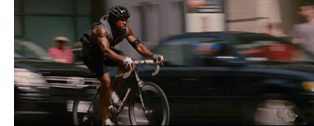 But Manny is a competitor. We’ve seen that he has his eye on Vanessa and he’s convinced he could beat Wilee in a race. So Manny’s personality, agreeable but aggressive, motivates delay, in the form of a prolonged chase/race that, inevitably, brings in the bike cop yet again. Meanwhile, the fact that Vanessa happens to be Nima’s roommate, and that she first put Monday on Nima’s trail, puts her into the mix, pedaling fast to converge with the three men. When she and Wilee finally meet, he hides the ticket in his bike’s handlebar, creating preconditions for the climax.
But Manny is a competitor. We’ve seen that he has his eye on Vanessa and he’s convinced he could beat Wilee in a race. So Manny’s personality, agreeable but aggressive, motivates delay, in the form of a prolonged chase/race that, inevitably, brings in the bike cop yet again. Meanwhile, the fact that Vanessa happens to be Nima’s roommate, and that she first put Monday on Nima’s trail, puts her into the mix, pedaling fast to converge with the three men. When she and Wilee finally meet, he hides the ticket in his bike’s handlebar, creating preconditions for the climax.
This section builds to a pile-up that ends with what we saw at the film’s beginning: Wilee sailing across the frame and landing on the pavement. Dazed, he remembers meeting Vanessa at a bar, where he won a prize as top messenger–the prize being the bike he’s been riding. Each of the three sections we’ve seen includes a flashback, but this is the first one presented as a character’s memory.
Climax (64:00-83:49)
One sign of a climax is this: We know everything we need to know. We know what the ticket means, what all the characters want, and what the stakes are. Now we just have to watch their plans work. In the ambulance, Wilee is suffering from cracked ribs, and Monday bends over him, whacking the ribs to make him talk. Wilee admits that he’ll tell everything if he can get his bike back. This is the make-or-break moment: The hero has to find a subterfuge that will accomplish his goal. Recovering the bike will allow him to retrieve the ticket.
The film has relied on crosscutting throughout, but now the technique expands and accelerates. Nima heads for Chinatown. Wilee’s bike is taken to the police impound facility, but Vanessa has followed it there and gets inside. Soon Wilee arrives with Monday, who searches Manny. Inside, Wilee and Vanessa recover the ticket and escape, courtesy of some very flashy bike-riding. They split up: Wilee to deliver the ticket, and Vanessa to assemble a flashmob.
From the start, during Wiley’s voice-over exposition, we’ve been aware that the couriers form a sort of countercultural community, and a very early scene showed bikers stopping to help fallen comrades. (Good old foreshadowing.) Now, as Wilee goes to deliver the ticket, he faces Monday, who has again caught up with him. The messenger community appears and Monday realizes he can’t fight them all. He’s killed by a Chinese gang member, introduced in part 2 and seen en route to the Chinatown showdown.
Wilee delivers the ticket to Sister Chen, and she phones the snakehead in China to report that the boy’s passage has been paid. Nima thanks Wilee, and in a canonical wrapup Vanessa and Wilee embrace. A brief epilogue echoes the beginning by showing Wilee back whizzing through the streets. “Can’t stop. Don’t want to.”
In Storytelling in the New Hollywood, Kristin points out that a film of 80-90 minutes might have only three parts, each 20-30 minutes long. I prefer my layout because it lets each of the first three sections have its own flashback, and it highlights the midpoint–the crucial moment of choice for Wilee. But proponents of a three-act structure would claim that their model accounts for the movie too. The setup would then run to the point at which Wilee escapes from the police station and calls Raj to tell him he wants no part of the deal; the complicating action would consist of Manny’s pickup and the ensuing chase; and the climax, as with my breakdown, would start when Wilee confronts Monday in the ambulance. In this respect, I think Premium Rush would be an enjoyable film to use in teaching some different approaches to Hollywood dramaturgy.
Personal velocity
From another angle, the first three parts (or two, if you insist) are themselves flashbacks from the opening shots. We’re introduced to Wilee as he sails against the sky in slow-motion, hurled from his bike and en route to hitting the pavement. Then in a kind of prologue the narration takes us back to him enthusiastically pedaling through the streets at 5:10 that day. His voice-over confides his love of biking, his refusal to use gears or brakes, and his preternatural ability to avoid collisions. In Wait Frank Partnoy shows how well-practiced athletes slow down their perception of time, giving themselves 200 milliseconds or more to decide how to return a tennis serve or a cricket shot. Thanks to CGI that plays out Wilee’s options within a split second, we see that he has that gift.
You can criticize voice-over exposition like Wilee’s as lazy screenwriting, and sometimes it is. But given the time pressure, both in the story’s deadlines and by the movie’s length, it creates a concise lead-in that sets the rapid pace of the little adventure we’re going on. The same pace informs the layout of the situations.
During the prologue, Vanessa gets concisely characterized. Nearly sideswiped by a cab, she punishes the driver by using her bike chain to amputate his outside mirror. Six minutes into the movie, Wilee gets his assignment; three minutes later he’s picking up the package. A minute or two after that, he’s accosted by the cop Monday. Then we’re off on a swift chase scene, shot and cut with a precision and economy largely missing from the two movie hulks mentioned above. The many stunts–most of them practical ones, not CGI-created; and many quite funny–keep you riveted to the screen. Likewise, the cascade of deadlines gives every scene a time pressure that’s only enhanced by hairbreadth escapes and near-misses in traffic.
Rapid pacing lets you slip smart things in casually, like the fact that Monday goes by the alias of Forrest J. Ackerman. The use of vaguely Googleized 3D maps, with Wilee’s route traced in yellow and his hypothetical zigzags in white, keeps us oriented briskly. Wilee’s swift, insolent repartee yields comic motifs, which I won’t spoil by specifying. Even the product placement has a jokey quality: these purportedly cool kids are stuck in a Columbia movie, so they all must use Sony Ericsson cellphones (1.8 % global market share last year).
The film employs the redundancy necessary to the Hollywood tradition, but in quickfire fashion. So, for instance, we learn in little bursts that Wilee rides without gears or brakes: he tells us, then later we see his handlebars and axles in close-up, still later Manny mocks his Old School simplicity, and then we see close-ups of Manny’s high-end gear. Finding fresh ways to repeat information is a measure of craft skill. You don’t just restate it; you do it once in words, then images, then contrasting images, and so on. But you can do it all so fast it doesn’t seem redundant. The payoff occurs when Vanessa, warned by Wilee that using brakes will kill her, has a serious crash. In one brief shot she angrily whacks off her brakes, bringing herself closer to his hell-for-leather ethic. Blink and you might miss it.
The film’s use of some common current conventions, like impersonal flashbacks that jigsaw together earlier events in different lines of action, adds to the sense of compression. The replays that show how the lines knot together are quick and simple. Above all, I congratulate director David Koepp, who also wrote the film with John Kamps, on avoiding the obvious. Lesser minds would have called our hero Road Runner and made the futile cop the Coyote figure. Wilee the biker combines the Coyote’s cosmic persistence with the Road Runner’s speed and vocalizations. Joseph Gordon-Leavitt’s grinning giggle comes pretty close to a meep-meep.
Above all, the film’s momentum comes from a plot motored by deadline-driven chases. No other medium can render the exhilaration of sheer headlong velocity. From the early 1900s up to today, cinema is drawn toward people, animals, and machines hurtling across the screen. Vanishing Point, Speed and Premium Rush are tapping the appeals exposed by great chases like those in Keaton’s Cops and The General and less-known Harold Lloyd masterpieces like Girl Shy and For Heaven’s Sake. I sometimes complain about post-1960s Hollywood, but I’ve got to admit that the revival of flamboyant set-piece chases in Burt Reynolds and Clint Eastwood movies, Raiders of the Lost Ark, and the action-adventure movies that followed have paid big dividends. Screen action doesn’t have to be rapid, but when it is, and when it involves a race against time, it can be transporting. Sometimes you just want a movie to move.
True, the summer comic-book sagas shift their bulk, but leadenly. When these zeppelins accelerate, they often burst into disjointed imagery. Premium Rush could be a textbook in how to give fast action a clean, cogent profile. When we see energetic movement that’s coherent, unpretentious, and inventive, gracefulness comes along as a bonus. You get another blossom in the Dead Zone.
Assuming that the summer ended on 26 August, Indiewire offers its analysis of summer trends. The most striking news: Overseas box office is about 2/3rds of the total.
Business over Labor Day weekend, which might also be counted as the end of summer, was somewhat stronger, with one robust win (The Possession, at $21 million). Box Office Mojo‘s report from 2 September doesn’t even mention Premium Rush, which is projected to finish Monday with a total to date of about $13.5 million. See also Leonard Klady’s summer wrapup at Movie City News.
Kristin discusses the structural patterns of mainstream American movies in the first chapter of Storytelling in the New Hollywood and offers many examples in later chapters. I test it on more recent cases in The Way Hollywood Tells It.
P.S. 4 September 2012: Thanks to a tweet from K. J. Hargan, I learn of a suit from a writer claiming that the movie is based on a novel he wrote in 1998. [2013 update: The plaintiff lost the case in April.]
P.P.S. 5 September 2012: David Koepp has written me with more information about his goals in making the film.
Nothing about Premium Rush was easy. The extreme nature of the work on the city streets, the physical risks to the actors and stunt performers, and our determination to find our entertainment value in real physical performance rather than CG work (except in certain obvious situations where it was played for laughs) all raised the degree of difficulty in their own way.
But one of the most gratifying things about your analysis was your appreciation of our structure, and how hard we worked to make a film of breathless brevity, in the great tradition of B pictures for decades. I realize that, as far as aesthetic criteria go, “short” doesn’t sound like a terribly high-minded one, but to me it was an essential guiding principle and a hard one to pull off. Your understanding of the value of a brisk pace and a tight running time made me smile, and your respect for the amount of love and effort some of us put into genre work is much appreciated.
Many thanks to David for the kind note.












